Croton plants (Codiaeum variegatum) are gorgeous red, green, and yellow patterned leaves that are evergreen and blooming in the tropics. Croton plants, such as the Croton “Petra,” are popular houseplants that flourish in bright settings with ordinary room temperatures. Croton plants are typically simple to maintain indoors.
Grow croton plants indoors Plant them in a well-draining potting mix and place them in bright indirect light. Room temperatures of 60°F to 70°F (16° – 21°C) are ideal for colorful croton plants. If crotons grow in cold drafts, they may drop their leaves. In the summer, mist the leaves often and keep them moist.
What is a Croton Plant?

Croton plants are tropical plant cultivars in the Codiaeum genus that feature gorgeous colorful leaves. Croton plants are valued houseplants despite their little flowers, whose vibrant leaves distinguish them. Each croton plant has a distinct look due to its various hues of red, yellow, orange, and violet.
Croton plants have thick leathery leaves, which distinguish them from other plants. Different cultivars have distinct leaf shapes, in addition to their stunning colors. Lanceolate, egg-shaped, violin-shaped, oblong, or thin and long leaf blades with patterned veins may be found. Multicolored leaves may be seen on one croton plant, giving it a fiery appearance.
Croton plants come in over 100 different varieties. Fire croton, variegated croton, and garden croton are some of the other names for these unusual houseplants. In tropical gardens, crotons plants are huge bushes that may reach 10 feet (3 meters) tall. A 12″ (30 cm) per season growth rate is typical of slow-growing pot plants.
A mature croton plant spreads 6 feet (1.8 meters) and has a rounded shape. Croton bushes are colorful garden privacy hedges or specimen plants that may be grown in USDA zones 10 and 11 due to their thick bushy foliage. Indoors, potted croton houseplants seldom reach more than 3 feet (1 meter). Croton plants produce lush, bushy foliage for many years as long as you take proper care of them.
What is Croton Petra?
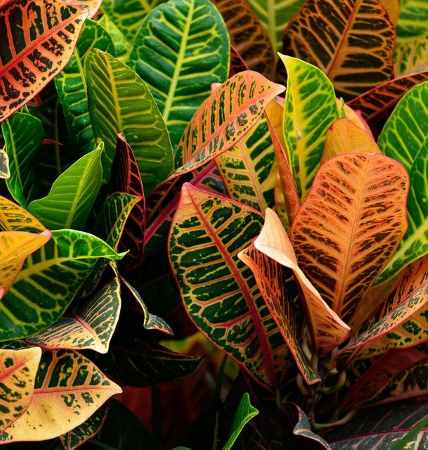
Croton ‘Petra’ (Codiaeum variegatum ‘Petra’) is a popular houseplant with exquisite, leathery leaves. The variegated foliage color of the Petra cultivar is magnificent. The vibrant veins are clear and obvious on the huge glossy leaves. Green and yellow, green and orange, or green and red leaves with pointed tips may be found on the ovate-shaped leaves.
Croton ‘Petra’ plant care
Croton cultivars such as Petra prefer indirect sunlight for six to eight hours a day. Grown in slightly moist soil, water the potting soil when it dries, and mist the plants weekly to ensure healthy growth. Fertilizing in the spring and summer promotes robust plant development and colorful bushy leaves. It’s critical to keep the Croton ‘Petra’ plant away from drafts or cold temperatures, as with most croton plants.
Croton Plant Flowers

When grown outside, all species of crotons produce creamy white male blooms that resemble stars. Croton plants, on the other hand, do not flower frequently when cultivated indoors. Among the glossy, leafy foliage, the small flower clusters can be difficult to see. Yet, rather than the small clusters of flowers, potted croton plants are prized for their leathery, glossy leaves.
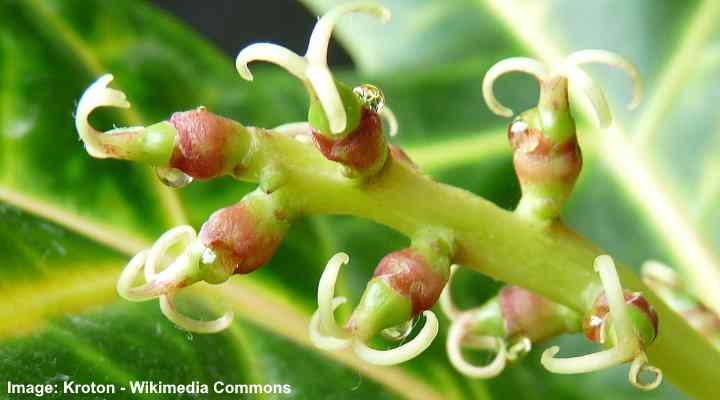
Croton female blooms don’t have petals, and their fruits become spherical when fertilized.
Why Are Croton Plants Popular?
Croton plants have lovely vibrant glossy leaves that make them a popular houseplant. Croton plants, while not blooming, can add color to any room in your house. You appreciate the vivid, multicolored leaves of these tropical plants all year long because they are evergreen. Croton shrubs are an excellent option to add brightness to a garden landscape if you live in USDA zones 10 and 11.
What Are the Different Croton Plant Varieties?
Codiaeum variegatum has cheerful bushy foliage in all colors. Croton plant types may be found here:
Croton Mammy. Multicolored, long, twisted growth and wavy margins characterize this daring houseplant.
Gold Dust Croton. The leaves of this croton plant are oblong and lustrous, with gold powdery specks and splotches that appear to be dusted.

Croton Magnificent. This croton has dark green and bright yellow variegation on its broad wavy leaves. The green leaves of some of these gorgeous crotons are orange or burgundy in color.
Bush on Fire Croton. Green, yellow, orange, and red variegation can be found on the long, pointed croton leaves.
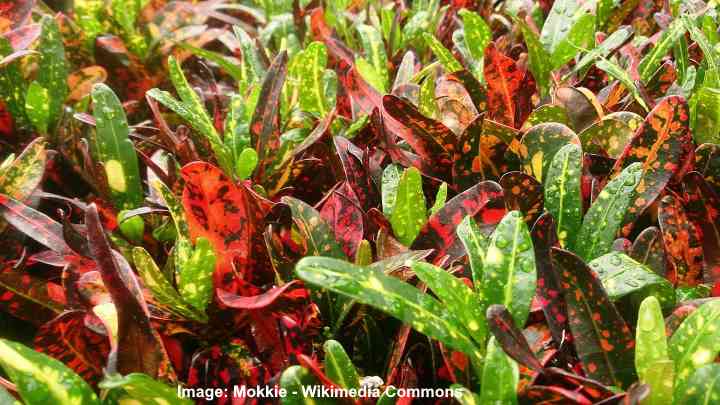
Banana Croton. The banana-shaped leaves of this tiny croton plant are bright yellow and green in color.
Croton Plant Care
If you get the lighting, watering, and temperature conditions right, croton plants are fairly simple to grow indoors. Avoid temperature fluctuations, keep the soil moist but not overly wet, and spray the leaves on a regular basis to look after croton plants. Croton plant leaves will not fall if you manage to get these care parameters right. Croton can be grown and cared for in several ways.
Light Requirements for Growing Croton Plants Indoors
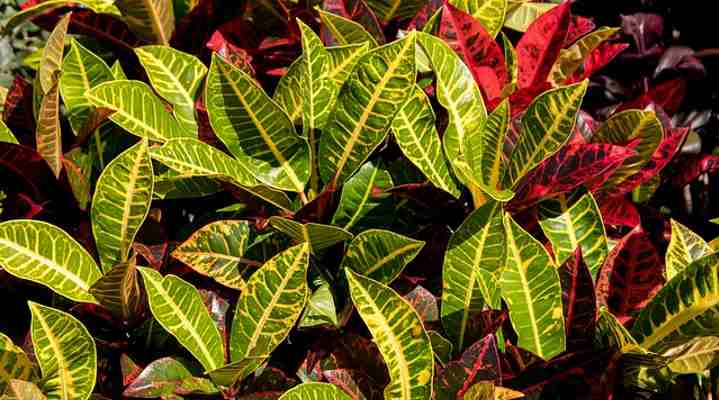
Croton plants thrive in a well-lit area that is shielded from direct sunlight. Croton varieties should ideally receive between six and eight hours of sunlight each day. Plants should be protected from excessive direct sunlight. The vivid colors on the gorgeous foliage are kept vibrant by bright indirect light.
A potted croton plant should be placed near a south or west-facing window for the best results. If there isn’t enough sunlight, the spectacular leaf colors will fade and appear washed-out. Croton plants, on the other hand, may fade their foliage colors if they are exposed to too much direct sunlight.
How Often to Water Croton Plants
When the top layer of soil dries out, water croton plants as frequently as possible. Test the potting soil for dryness every week during spring and summer. It’s a indication that you’ll want to water the moisture-loving plant if the top 0.5″ (1.2 cm) is dry. Wait until the soil is drier before watering the top of the soil. Tropical, humid environments are ideal for croton plants.
As a result, the soil should be kept moist at all times. Roots will rot if there is too much moisture in the potting soil. Crotons, on the other hand, are not drought tolerant. As a result, the soil can never be too dry; otherwise, the magnificent leaves will begin to fade.
Croton plants prefer lots of moisture, as you may remember. Only water when the top of the soil feels dry to prevent overwatering. The soil should be watered on a regular basis to keep it moist, and allowing it to dry just slightly protects the roots from becoming waterlogged.
The Best Kind of Soil for Croton Houseplants
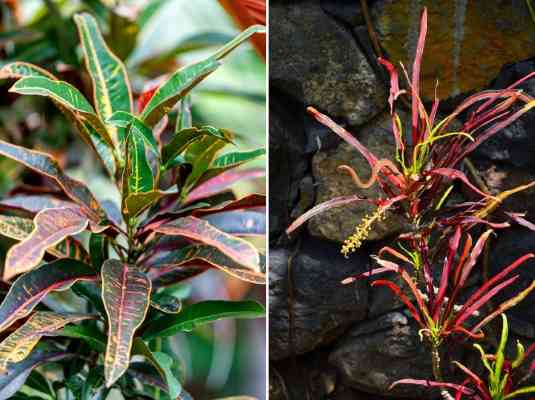
Croton plants thrive in a moist potting medium that has excellent drainage. Grow them in a well-draining medium. The perfect soil mix for healthy croton plants is a combination of regular houseplant soil, peat moss, and perlite. Excess water drains rapidly from this kind of potting soil, yet the roots are kept moist because it retains enough moisture.
Croton plants sitting in waterlogged soil is the worst thing they can do. Here are a few tips for determining that the potting soil best suits these tropical plants’ needs:
- Only use pots with drainage holes in the bottom to grow croton plants.
- To allow water to drain quickly, make sure the soil is light and loose.
- If your croton plants get rootbound, repot them.
- If water begins to pool on the surface, add perlite and peat moss to the potting mix.
What Temperature Does Croton Indoor Plants Grow Best?
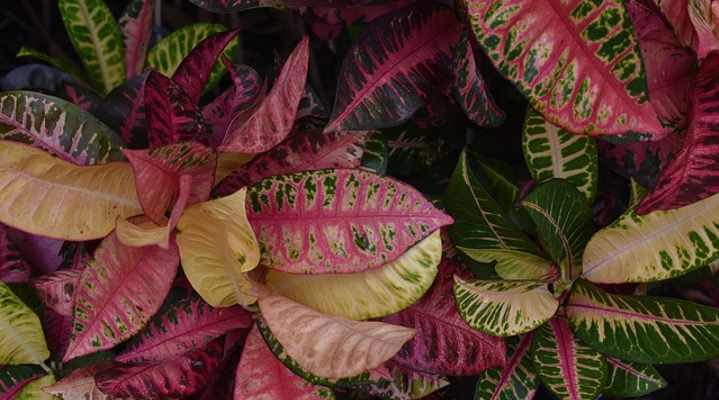
Croton plants require a temperature range of 60°F to 70°F (16° – 21°C) to survive. Crotons have an optimal temperature of 80°F (26°C), with a minimum of 55°F (12°C). Croton plants are most commonly seen in bright conditions, so they may flourish in average room temperatures.
Tropical plants should be kept away from chilly drafts. If you live in USDA zones 10 or 11, croton shrubs may be found in your front or backyards. Croton plants may be grown in zone 9 in some inland regions that are not close to the sea. However, from winds and temperatures below 55°F (12°C), you’ll need to protect the heat-loving plant.
You may bring potted croton plants outside in the summer in temperate areas. Place the plant pot in a protected, sunny area. These bushy foliage plants bring a lot of bright hues to your balcony, patio, or deck. Cold drafts are affecting your tropical potted plant, which is evidenced by leaf drop. Croton houseplants may be chilled by drafts from open doors, windows, or air conditioning. Croton plant growth can also be affected by hot air from air ducts.
Humidity Requirements for Growing Croton Plants Indoors

Croton houseplants need at least 40% humidity, so they are watered once or twice a week. Getting air moisture levels correct is difficult because household air is usually too dry, particularly when the heating is on. To keep the humidity level consistent, you’ll need to spray leaves once or twice a week. To encourage humidity for your lovely croton plant, here are a few helpful suggestions:
- Weekly, use a wet cloth to clean the leaves and remove dust.
- On consecutive weeks, Mist uses filtered water at ambient temperature to drink.
- Fill a tray with pebbles and place your potted croton plant on top. Pour enough water to half fill the tray.
- Keep the humidity level at least 40% by using a humidifier in your room.
- To create a more humid environment, group your houseplants.
Leaf drop is one of the first signs that your colorful croton plant is thirsty.
How to Propagate a Croton Plant
Cuttings from a healthy plant are the most effective way to propagate croton. The severed stem emits a milky, white sap when being propagated as cuttings. In humans, this irritant may cause dermatitis. When cutting croton stems, wear protective gloves at all times. Cut a 3″ to 4″ (7.5 – 10 cm) stem with at least three leaves to grow a croton plant.
Allow the wound to heal by laying the croton on a paper towel for a few days. In a loose potting soil, plant the stem cutting.
Placed the potted cutting in a bright area, covered it with a plastic bag to create a humid, warm environment, and make sure the earth is moist to help your propagated cutting take root. The plant should have roots after a few weeks, and you may treat it like any other croton plant.
How to Prune a Croton Houseplant
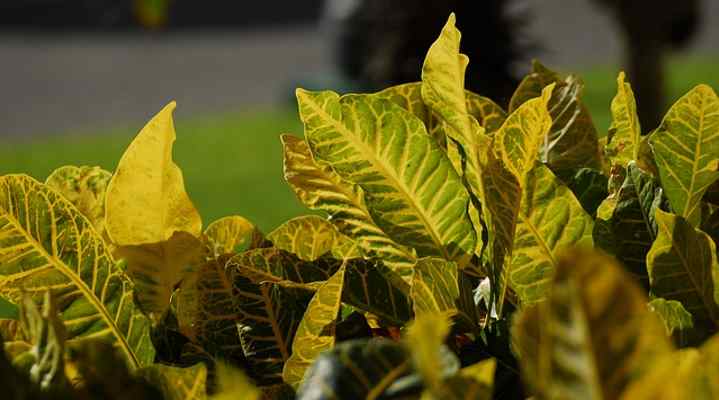
To regulate croton plant height or create a bushier appearance, you may prune it. Pruning isn’t always necessary to encourage more growth in croton plants, because their dense, bushy foliage naturally encourages growth. Cut the leaf stem where it connects to the plant to eliminate dead leaves. Trim leggy stems just above a node to remove them.
Croton plants may grow up to 6–10 feet (1.8–3 meters) tall. In order to control the plant’s height, pruning it is a good idea. All you have to do is choose the length you want and cut the stem. The plant’s foliage becomes even bushier when it is trimmed. To prevent the white sap from bothering your skin, remember to wear gloves while pruning croton leaves or stems.
Repotting Croton Plants
Repot the croton plant in the spring if it has become rootbound. Always select a container that is one size bigger than the one you have now. Just remove the leafy plant from the existing container and shake off any loose soil to complete the process. Plant in a new container, fill with the proper potting material, and make sure the plant is growing at the same level as it was previously. Water the plant thoroughly.
Are Croton Plants Poisonous?
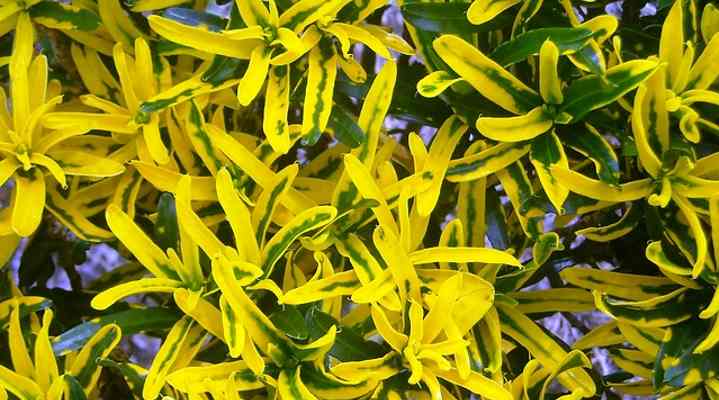
Croton (Codiaeum variegatum) is harmful to people and animals. Croton leaves and stems contain a poisonous milky sap that is dangerous to cats and dogs. When the white liquid comes into contact with the skin, it can cause irritation. This might induce dogs to drool excessively or experience oral discomfort. According to NC State Extension researchers, the plant is only harmful when consumed in huge amounts.
Pests Affect Croton Plant Growth
It’s vital to get rid of bugs from a croton plant’s leaves or stem as soon as possible. Add 2 tsp. of salt to the recipe. 1 cup neem oil In a spray bottle, mix one quart of warm water with tsp dish soap. To get rid of the pests, liberally spray both sides of the croton plant’s leaves every week. In addition, you may kill plant pests on contact with a cotton pad drenched in rubbing alcohol.
Croton plants are typically pest resistant. Mealybugs, thrips, scale insects, and spider mites can all harm your plant’s development. Houseplant pests leach the sap from plants, eventually hindering their development.
Diseases Affecting Croton Houseplants
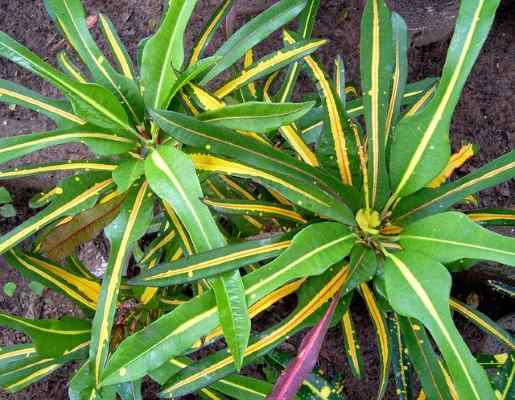
Root rot is a common problem that affects the growth of croton plants, and it usually manifests itself as leaves falling. watering your tropical houseplant properly can help you avoid roots from rotting. The root system of a plant decays and dies when soil is excessively damp or waterlogged.
Leaves that fall from the plant are frequently the first symptom of root rot. To avoid fungal and bacterial diseases, top croton plant care advice is to keep the growing medium moist without it becoming too soggy.
Croton Plant Care: FAQs
Croton plants are simple to cultivate, but if the weather isn’t favorable, they may be difficult. Here are some tips for growing croton plants successfully indoors.
Why is my croton plant dropping its leaves?
Croton leaves often fall off due to watering problems or chilly drafts. Croton roots rot due to overwatering. As a result, the plant can’t receive enough nutrients. As a consequence, before succumbing to disease, the croton leaves sag. Dry soil, on the other hand, will cause leaves to fall due to the moisture-loving plant’s dehydration.
So, if you are watering the croton plant correctly and leaves are still falling, what’s going on? In that case, make sure the plant isn’t exposed to direct sunlight for too long or exposed to chilly drafts.
How can I revive a dying croton plant?
If you fix the underlying care issue, you may revive a dying croton plant. Croton plants are fairly tolerant of adversity. You may still bring back the plant by repotting it in a new potting mixture, altering your watering regimen, or shifting its location even if many leaves have fallen away.
Where to grow croton plants in winter
During the winter, croton plants prefer to grow near a south-facing window. Croton plants require special attention throughout the winter, but they don’t become dormant. As a result, give them at least two or three hours of sunlight every day. When the top 1″ to 2″ (2.5 cm – 5 cm) of soil is dry, water the plants from time to time. Because household heating may make the air too dry for croton plants, you’ll need to maintain humidity levels high throughout the winter.
